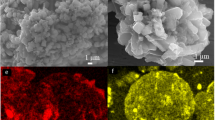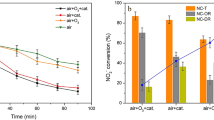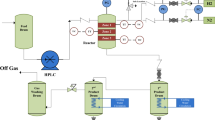Abstract
Modification of the adsorbent substrates surface with the aim of improving performance is an important field of study in toxic airborne contaminants removal. In the present study, the effect of adding magnetite nanoparticles to zeolite ZSM-5 and Y substrates was investigated. Hydrogen sulfide removal at high temperatures by the two substrates was compared, and magnetite nanoparticles with 3% and 5% weight ratio were loaded to ZSM-5 and Y zeolite substrates. Substrate properties were analyzed using X-ray diffraction, BET method, scanning electron microscope and Fourier transform infrared spectroscopy tests. Then, hydrogen sulfide was prepared in concentrations of 30, 60, 90 and 120 ppm at temperatures of 100, 200 and 300 °C in a pilot system. The removal efficiency of the synthesized surfaces was measured. The results show that the Y substrate, compared to the ZSM-5% substrate, had more meso- and micropores which is a result of the loading of magnetite nanoparticles causing a reduction in their pores surface. Increasing the temperature and loading percentage of magnetite nanoparticles on both zeolite substrates also increased the breakthrough time (P ≤ 0.05). The highest adsorption capacity observed was for Y-magnetite-5% substrate at a 120 ppm concentration. The results also show that the higher porosity of the zeolite substrate plays a significant role in the removal ability of contaminants. Additionally, modification of the pores with magnetite nanoparticles can increase their efficiency in high-temperature hydrogen sulfide removal. It can be concluded that the modification of zeolite substrates with catalytic nanoparticles is a suitable method for the removal of similar pollutants.






Similar content being viewed by others
References
Alonso-Vicario A, Ochoa-Gómez JR, Gil-Río S, Gómez-Jiménez-Aberasturi O, Ramírez-López C, Torrecilla-Soria J, Domínguez A (2010) Purification and upgrading of biogas by pressure swing adsorption on synthetic and natural zeolites. Microporous Mesoporous Mater 134:100–107
Bae YS, Yazaydın AÖ, Snurr RQ (2010) Evaluation of the BET method for determining surface areas of MOFs and zeolites that contain ultra-micropores. Langmuir 26:5475–5483. https://doi.org/10.1021/la100449z
Bikshapathi M, Singh S, Bhaduri B, Mathur GN, Sharma A, Verma N (2012) Fe-nanoparticles dispersed carbon micro and nanofibers: surfactant-mediated preparation and application to the removal of gaseous VOCs. Colloids Surf A 399:46–55
Cosoli P, Ferrone M, Pricl S, Fermeglia M (2008) Hydrogen sulphide removal from biogas by zeolite adsorption: part I. GCMC molecular simulations. Chem Eng J 145:86–92
Eltouny NA, Ariya PA (2012) Fe3O4 nanoparticles and carboxymethyl cellulose: a green option for the removal of atmospheric benzene, toluene, ethylbenzene, and o-xylene (BTEX). Ind Eng Chem Res 51:12787–12795
Golbabaei F, Rahmanzadeh E, Moussavi G, Baneshi M (2014) Fixed bed adsorption of hexavalent chromium onto natural zeolite from air stream. Saf Health Work 4:1–14
Jin T, Yang Q, Meng C, Xu J, Liu H, Hu J, Ling H (2014) Promoting desulfurization capacity and separation efficiency simultaneously by the novel magnetic Fe3O4@PAA@MOF-199. RSC Adv 4:41902–41909
Liu D, Zhou W, Wu J (2016a) CeO2–MnOx/ZSM-5 sorbents for H2S removal at high temperature. Chem Eng J 284:862–871
Liu D, Zhou W, Wu J (2016b) La2CuO4/ZSM-5 sorbents for high-temperature desulphurization. Fuel 177:251–259
Lu A, Salabas E, Schüth F (2007) Magnetic nanoparticles: synthesis, protection, functionalization, and application. Angew Chem Int Ed Engl 46:1222–1244
Moradiganjeh J, Aghajani Z (2016) Synthesis and characterization of novel magnetic Fe3O4/C through the co-precipitation method and investigation of its desulfurization application. J Mater Sci: Mater Electron 27:5948–5953
Mureddu M et al (2012) ZnO/SBA-15 composites for mid-temperature removal of H2S: synthesis, performance and regeneration studies. Fuel 102:691–700
Oliveira LC, Petkowicz DI, Smaniotto A, Pergher SB (2004) Magnetic zeolites: a new adsorbent for removal of metallic contaminants from water. Water Res 38:3699–3704
Pérez-Ramírez J, Groen J, Brückner A, Kumar MS, Bentrup U, Debbagh M, Villaescusa L (2005) Evolution of isomorphously substituted iron zeolites during activation: comparison of Fe-beta and Fe-ZSM-5. J Catal 232:318–334
Popescu RC et al (2017) Fabrication and cytotoxicity of gemcitabine-functionalized magnetite nanoparticles. Molecules 22:1080
Rangkooy HA, NakhaeiPour M, Fouladi Dehaghi B (2017a) Efficiency evaluation of the photocatalytic degradation of zinc oxide nanoparticles immobilized on modified zeolites in the removal of styrene vapor from air. Korean J Chem Eng 34:3142–3149
Rangkooy HA, Pour MN, Dehaghi BF (2017b) Efficiency evaluation of the photocatalytic degradation of zinc oxide nanoparticles immobilized on modified zeolites in the removal of styrene vapor from air. Korean J Chem Eng 34:3142–3149
Rau JY, Chen JC, Huang ST, Hung WT, Wey MY (2011) Removals of fly ash and NO in a fluidized-bed reactor with CuO/activated carbon catalysts. J Hazard Mater 187:190–198
Reyes-Carmona Á, Soriano MD, Nieto JML, Jones DJ, Jiménez-Jiménez J, Jiménez-López A, Rodríguez-Castellón E (2013) Iron-containing SBA-15 as catalyst for partial oxidation of hydrogen sulfide. Catal Today 210:117–123
Rezaei F, Moussavi G, Riyahi Bakhtiari A, Yamini Y (2016) Toluene adsorption from waste air stream using activated carbon impregnated with manganese and magnesium metal oxides. Iran J Health Environ 8:491–508
Rostami R, Jonidi Jafari A, Rezaee Kalantari R, Gholami M (2012) Survey of modified clinoptilolite zeolite and cooper oxide nanoparticles-containing modified clinoptilolite efficiency for polluted air BTX removal. Iran J Health Environ 5:1–8
Sakanishi K et al (2005) Simultaneous removal of H2S and COS using activated carbons and their supported catalysts. Catal Today 104:94–100
Salehnia S, Barikbin B, Dorri H (2016) The efficiency of magnetic carbon activated by iron oxide nanoparticles in removing of Cu(II) from aqueous solutions. J Birjand Univ Med Sci 23:44–55
Shangol AB, Mortazavi SB, Asilian H, Kazemian H (2013) Elimination of toluene vapours using natural zeolite treated by copper oxide. J Kermanshah Univ Med Sci 17:423–430
Sing KS (1985) Reporting physisorption data for gas/solid systems with special reference to the determination of surface area and porosity (Recommendations 1984). Pure Appl Chem 57:603–619
Theodore L (2008) Air pollution control equipment calculations. Wiley, Hoboken
Wang X, Ma X, Xu X, Sun L, Song C (2008a) Mesoporous-molecular-sieve-supported polymer sorbents for removing H2S from hydrogen gas streams. Top Catal 49:108–117
Wang X, Sun T, Yang J, Zhao L, Jia J (2008b) Low-temperature H2S removal from gas streams with SBA-15 supported ZnO nanoparticles. Chem Eng J 142:48–55
Xie W, Chang L, Wang D, Xie K, Wall T, Yu J (2010) Removal of sulfur at high temperatures using iron-based sorbents supported on fine coal ash. Fuel 89:868–873
Yazdanbakhsh F, Bläsing M, Sawada JA, Rezaei S, Müller M, Baumann S, Kuznicki SM (2014) Copper exchanged nanotitanate for high temperature H2S adsorption. Ind Eng Chem Res 53:11734–11739
Zhang Z, Liu B, Wang F, Li J (2013) Fabrication and performance of x Mn y Ce/hexagonal mesoporous silica sorbents with wormhole-like framework for hot coal gas desulfurization. Energy Fuels 27:7754–7761
Zhao SY, Lee DG, Kim CW, Cha HG, Kim YH, Kang YS (2006) Synthesis of magnetic nanoparticles of Fe3O4 and CoFe2O4 and their surface modification by surfactant adsorption. Bull Korean Chem Soc 27:237–242
Acknowledgements
The authors would like to thank the Health Faculty of Shahid Beheshti University of Medical Sciences for providing laboratory facilities and for funding the present research under the Code 8983.
Funding
This work was supported by School of Public Health at the Shahid Beheshti University of Medical Sciences (Grant No. 8983).
Author information
Authors and Affiliations
Corresponding author
Ethics declarations
Conflict of interest
The authors declare that they have no conflict of interest.
Additional information
Editorial responsibility: Josef Trögl.
Rights and permissions
About this article
Cite this article
Jafari, M.J., Zendehdel, R., Rafieepour, A. et al. Comparison of Y and ZSM-5 zeolite modified with magnetite nanoparticles in removal of hydrogen sulfide from air. Int. J. Environ. Sci. Technol. 17, 187–194 (2020). https://doi.org/10.1007/s13762-019-02348-w
Received:
Revised:
Accepted:
Published:
Issue Date:
DOI: https://doi.org/10.1007/s13762-019-02348-w




